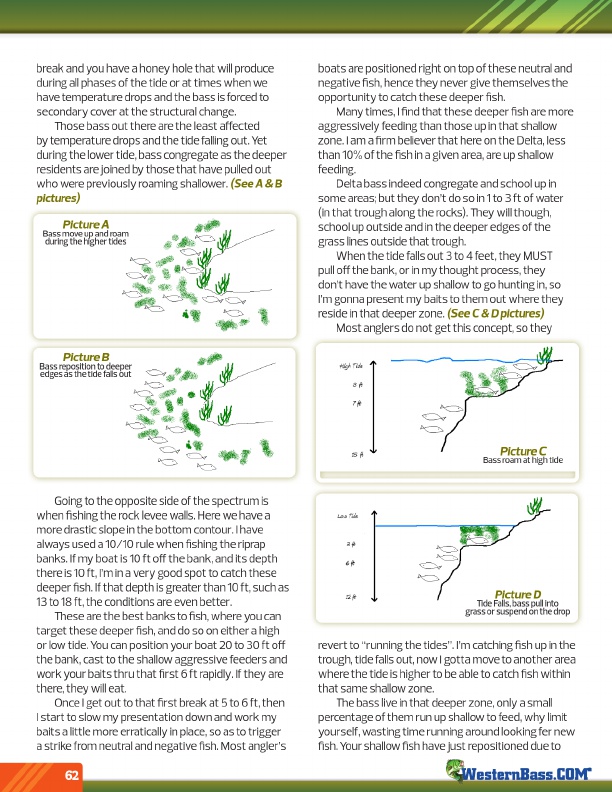
®
break and you have a honey hole that will produce during all phases of the tide or at times when we have temperature drops and the bass is forced to secondary cover at the structural change.
Those bass out there are the least affected by temperature drops and the tide falling out. Yet during the lower tide, bass congregate as the deeper residents are joined by those that have pulled out who were previously roaming shallower. (See A & B pictures)
Bdausrsinm P g ot ic hve t e u huip r g e hane A dr triodaems
Bass re P p i o c s t it u io r n e to B deeper
edges as the tide falls out
boats are positioned right on top of these neutral and negative fish, hence they never give themselves the opportunity to catch these deeper fish.
Many times, I find that these deeper fish are more aggressively feeding than those up in that shallow zone. I am a firm believer that here on the Delta, less than 10% of the fish in a given area, are up shallow feeding.
Delta bass indeed congregate and school up in some areas; but they don’t do so in 1 to 3 ft of water (in that trough along the rocks). They will though, school up outside and in the deeper edges of the grass lines outside that trough.
When the tide falls out 3 to 4 feet, they MUST pull off the bank, or in my thought process, they don’t have the water up shallow to go hunting in, so I’m gonna present my baits to them out where they reside in that deeper zone. (See C & D pictures)
Most anglers do not get this concept, so they
Bass P ro ic am tu a r t e hig C h tide
Going to the opposite side of the spectrum is when fishing the rock levee walls. Here we have a more drastic slope in the bottom contour. I have always used a 10/10 rule when fishing the riprap banks. If my boat is 10 ft off the bank, and its depth there is 10 ft, I’m in a very good spot to catch these deeper fish. If that depth is greater than 10 ft, such as 13 to 18 ft, the conditions are even better.
These are the best banks to fish, where you can target these deeper fish, and do so on either a high or low tide. You can position your boat 20 to 30 ft off the bank, cast to the shallow aggressive feeders and work your baits thru that first 6 ft rapidly. If they are there, they will eat.
Once I get out to that first break at 5 to 6 ft, then I start to slow my presentation down and work my baits a little more erratically in place, so as to trigger a strike from neutral and negative fish. Most angler’s
62
graTsisdoerF P sau i ll c ssp, t be u an r sd e sop D nutllhinetdorop
revert to “running the tides”. I’m catching fish up in the trough, tide falls out, now I gotta move to another area where the tide is higher to be able to catch fish within that same shallow zone.
The bass live in that deeper zone, only a small percentage of them run up shallow to feed, why limit yourself, wasting time running around looking fer new fish. Your shallow fish have just repositioned due to